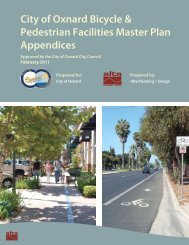Santa Clara River Trail Final Master Plan - Development Services ...
Santa Clara River Trail Final Master Plan - Development Services ...
Santa Clara River Trail Final Master Plan - Development Services ...
You also want an ePaper? Increase the reach of your titles
YUMPU automatically turns print PDFs into web optimized ePapers that Google loves.
<strong>Santa</strong> <strong>Clara</strong> <strong>River</strong> <strong>Trail</strong> <strong>Plan</strong><br />
Townsend’s big-eared bat (Corynorhinus townsendii), and coast horned lizard (Phrynosoma coronatum) are<br />
also known to occur in the vicinity. Additional species of concern that could occur due to the presence of<br />
potentially suitable habitat and range include the southwestern willow flycatcher (Empidonax traillii<br />
extimus), arroyo toad (Bufo californicus), and California red-legged frog (Rana aurora draytonii). However,<br />
these species have not been recorded in the project vicinity. The density of plant growth in combination<br />
with the linear quality of the river make the riverbed an important wildlife corridor for larger species as<br />
well, including coyotes and deer.<br />
Approximately 2 miles downstream (west) of the project site, the river supports a large area of riparian<br />
habitat upstream of the river’s estuary. This estuary has been noted to be a major stopover for migratory<br />
and/or breeding species of shorebirds and waterfowl, including the endangered California least tern<br />
(Sterna antillarum browni) (City of Oxnard 2004). The estuary is also known to support the tidewater goby<br />
(Eucyclogobius newberryi) and western snowy plover (Charadrius alexandrinus nivosus). The Ventura marsh<br />
milk-vetch (Astragalus pycnostachyus var. lanosissimus), an endangered species, has also been identified in<br />
this area.<br />
Although quality riparian habitat exists along significant portions of the riverbed, disturbance along the<br />
edges of the floodplain and upland areas can be substantial. <strong>Trail</strong>s are found throughout the riverbed,<br />
which are apparently used by off-road vehicles as well as foot traffic. These trails appear to be mostly<br />
limited to the edges of the floodplain, as there is little evidence of such use within the riverbed adjacent<br />
to the project site. Further, exotic (i.e., invasive) vegetation has degraded native habitats in some areas,<br />
particularly giant reed (Arundo donax) and salt cedar (Tamarix spp.), although no exotic species dominate<br />
habitats in the immediate project vicinity (Caltrans 2001).<br />
GEOLOGY AND SOILS<br />
The proposed project is located near the center of the Oxnard Plain, a broad alluvial basin that is filled<br />
with sediments, sands, and gravels deposited by the <strong>Santa</strong> <strong>Clara</strong> <strong>River</strong>. These sand and gravel deposits<br />
are generally characterized as being rich in minerals but unsuitable for agriculture. These alluvial soils are<br />
prone to compaction and liquefaction, and the potential for liquefaction is increased by the high<br />
groundwater level found in the region. Compaction of alluvial soils caused by seismic events has the<br />
potential to affect the project area, with a potential settlement of 1-2 feet projected for the region (City of<br />
Oxnard 2004).<br />
The project vicinity is located within a seismically active region subject to the effects of moderate to large<br />
earthquake events along major faults (City of Oxnard 2004). No active faults have been mapped across<br />
the study area. Several active and potentially active regional faults that may affect the area include the<br />
San Andreas Fault, the Simi-<strong>Santa</strong> Rosa fault system, the Oakridge fault system, the <strong>Santa</strong> Monica-<br />
Anacapa and Malibu fault zones and the Ventura-Pitas Point faults, all within 60 miles from the<br />
proposed project area. A complete description of area geologic resources can be found in the City of<br />
Oxnard 2030 General <strong>Plan</strong>, Open Space/ Conservation Element.<br />
HAZARDS AND HAZARDOUS MATERIALS<br />
There is potential for hazards and hazardous materials to exist within the project area. Natural hazards<br />
are described in Geology and Soils above and Hydrology and Water Quality below. Previous uses of hazardous<br />
City of Oxnard | 7
















